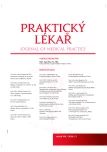Biochemical markers as a part of prenatal screening of chromosomal aberrations in the Czech Republic
Authors:
A. Šípek jr. 1,2,3; V. Gregor 2,4; J. Klaschka 5,6; M. Malý 5,7
; A. Šípek 2,3,4,8
Authors‘ workplace:
Ústav biologie a lékařské genetiky 1. LF UK a VFN, Praha, Přednosta: prof. MUDr. Ondřej Šeda, Ph. D.
1; Thomayerova nemocnice, Praha, Oddělení lékařské genetiky, Primářka: MUDr. Martina Langová, Ph. D.
2; Ústav lékařské genetiky 3. LF UK, Praha, Přednostka: prof. MUDr. Marie Černá, DrSc.
3; Oddělení lékařské genetiky, Sanatorium Pronatal, Praha, Ředitel pro léčebnou péči: doc. MUDr. Tonko Mardešić, CSc.
4; Ústav informatiky Akademie věd České republiky, Praha, Ředitel: prof. Ing. Emil Pelikán, CSc.
5; Ústav biofyziky a informatiky 1. LF UK, Praha, Přednosta: prof. MUDr. RNDr. Jiří Beneš, CSc.
6; Státní zdravotní ústav, Praha, Ředitel: MUDr. Pavel Březovský, MBA
7; GENNET s. r. o., Praha, Vedoucí lékař: MUDr. David Stejskal
8
Published in:
Prakt. Lék. 2020; 100(3): 126-130
Category:
Of different specialties
Overview
Introduction: Analysis of biochemical marker is an important part of the prenatal screening examinations – calculating the risk of chromosomal aberrations of the foetus. The aim of this study is to evaluate the effectiveness of these methods in the Czech Republic.
Methods: We present a retrospective epidemiological study using the data from the National registry of congenital anomalies, which is run by the institute of Health information and statistics of the Czech Republic. Additional information on prenatally diagnosed cases are obtained actively under the patronage of Society of Medical genetics and genomics of the Czech Medical Association. We analyzed the prenatal diagnostics of chromosomal aberrations (codes Q90-Q99) during 1994–2017 time period.
Results: In 2017 the biochemical (combined, or integrated) screening test was the referral for (successful) prenatal diagnosis of Down syndrome in 92.5% of cases, while at the beginning of the selected time period it was only in 13.46% of cases. During the selected time period – the incidence of Down syndrome in live births decreased significantly (from 7.79 per 10 000 live births in 1994 to 3.48 per 10 000 live births in 2017). The average week of gestation at the positive prenatal diagnosis of Down syndrome decreased from 20.33 in 1994 to 13.97 in 2017.
Discussion: During last twenty years the effectiveness of prenatal screening of chromosomal aberrations in the Czech Republic increased significantly. In our retrospective epidemiological study, we observed the effect of sole combined screening test of the first trimester, or integrated screening test on the increase in prenatal detection rate of Down syndrome. The diagnostics is also now performed earlier during the pregnancy and the number of invasive diagnostics procedures decreased.
Keywords:
Genetics – Chromosomal aberrations – biochemical screening
Sources
1. Ferguson-Smith MA. History and evolution of cytogenetics. Mol Cytogenet. 2015; 8: 19 [online]. Dostupné z https://molecularcytogenetics.biomedcentral.com/articles/10.1186/s13039-015-0125-8 [cit. 2020-02-04].
2. Ghi T, Sotiriadis A, Calda P, et al. ISUOG Practice Guidelines: invasive procedures for prenatal diagnosis. Ultrasound Obstet Gynecol 2016; 48(2): 256–268.
3. Hixson L, Goel S, Schuber P, et al. An overview on prenatal screening for chromosomal aberrations. J Lab Autom 2015; 20(5): 562–573.
4. Calda P, Víšková H, Bezdíčková D, Zima T. Prenatální diagnostika v prvním trimestru gravidity v klinické praxi. Čas. Lék. čes. 2006; 145(7): 575–577.
5. Nicolaides KH. Nuchal translucency and other first-trimester sonographic markers of chromosomal abnormalities. Am J Obstet Gynecol 2004; 191(1): 45–67.
6. Loucký J, Springer D, Šubrt I. Doporučení o laboratorním screeningu vrozených vývojových vad v prvním a druhém trimestru těhotenství. Klin Biochem Metab 2015; 44(1): 27–30.
7. Šípek A, Gregor V, Horáček J, Šípek A, Jr. National registry of congenital anomalies of the Czech Republic: commemorating 50 years of the official registration. Cent Eur J Public Health 2014; 22(4): 287–288.
8. Leoncini E, Botto LD, Cocchi G, et al. How valid are the rates of Down syndrome internationally? Findings from the International Clearinghouse for Birth Defects Surveillance and Research. Am J Med Genet A 2010; 152A(7): 1670–1680.
9. Calda P, Šípek A, Gregor V. Gradual implementation of first trimester screening in a population with a prior screening strategy: population based cohort study. Acta Obstet Gynecol Scand 2010; 89(8): 1029–1033.
10. Cocchi G, Gualdi S, Bower C, et al. International trends of Down syndrome 1993–2004: Births in relation to maternal age and terminations of pregnancies. Birth Defects Res A Clin Mol Teratol 2010; 88(6): 474–479.
Labels
General practitioner for children and adolescents General practitioner for adultsArticle was published in
General Practitioner

2020 Issue 3
- Memantine Eases Daily Life for Patients and Caregivers
- Metamizole vs. Tramadol in Postoperative Analgesia
- Metamizole at a Glance and in Practice – Effective Non-Opioid Analgesic for All Ages
- Memantine in Dementia Therapy – Current Findings and Possible Future Applications
- What Effect Can Be Expected from Limosilactobacillus reuteri in Mucositis and Peri-Implantitis?
Most read in this issue
- Diagnosis and treatment of Latent Autoimmune Diabetes in Adults in everyday clinical practice
- Methods of non-pharmacological treatment in rheumatoid arthritis
- Current possibilities of diagnostics and treatment of cartilaginous lesions of weight-bearing joints
- The role of the nurse and secondary prevention of stroke
